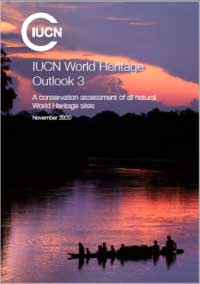IUCN World Heritage Outlook 3 report
The IUCN World Heritage Outlook 3 launched on 2 December 2020 shows that climate change is now the most prevalent threat, affecting a third of natural sites.
The results of the IUCN World Heritage Outlook 3 indicate that for 63% of all sites (159) the conservation outlook is either “good” or “good with some concerns”, while for 30% (75 sites) the outlook is of “significant concern”, and for 7% (18 sites) it is assessed as “critical”. These results are for the 252 natural World Heritage sites listed as of November 2020, including new sites which have been inscribed on the World Heritage List since the 2017 report.
The 2020 results for all 252 natural World Heritage sites show that just 50% of sites have effective or highly effective protection and management overall.
The conservation outlook for natural World Heritage sites in 2020 is similar to the overall results in 2017, with a 1% decrease in sites assessed as either “good” or “good with some concerns” between 2017 and 2020. It shows that conservation prospects remain positive for almost two thirds of all natural sites, while also indicating that further significant efforts are required to improve the outlook of many sites.
According to this report , Climate change continues to affect more and more natural World Heritage sites. In 2014, climate change was identified as the most significant potential threat, and in 2017, it became the fastest growing threat. In 2020, climate change has become the most prevalent current threat, and still remains by far the largest potential threat.
According to IUCN 2020 report, the conservation outlook of the mountain chain of the Western Ghats, one of the worlds eight hottest hot spots of biological diversity, is of significant concern. Western Ghats was inscribed by UNESCO in 2012 as a natural world heritage site. Fragmentation caused by development pressure in the Western Ghats are shrinking the availability of wildlife corridors and suitable habitats outside protected areas.
According to this report , Functional corridors that assure wildlife movement between protected areas are required and this is a great lacuna in the conservation scenario in Western Ghats and India as a whole. Corridors have been identified, but no sustained and sincere efforts have been taken to establish them. One such example in Western Ghats is the Ariankavu corridor between the Periyar-Agasthyamalai landscapes.








